Page 23 of 342
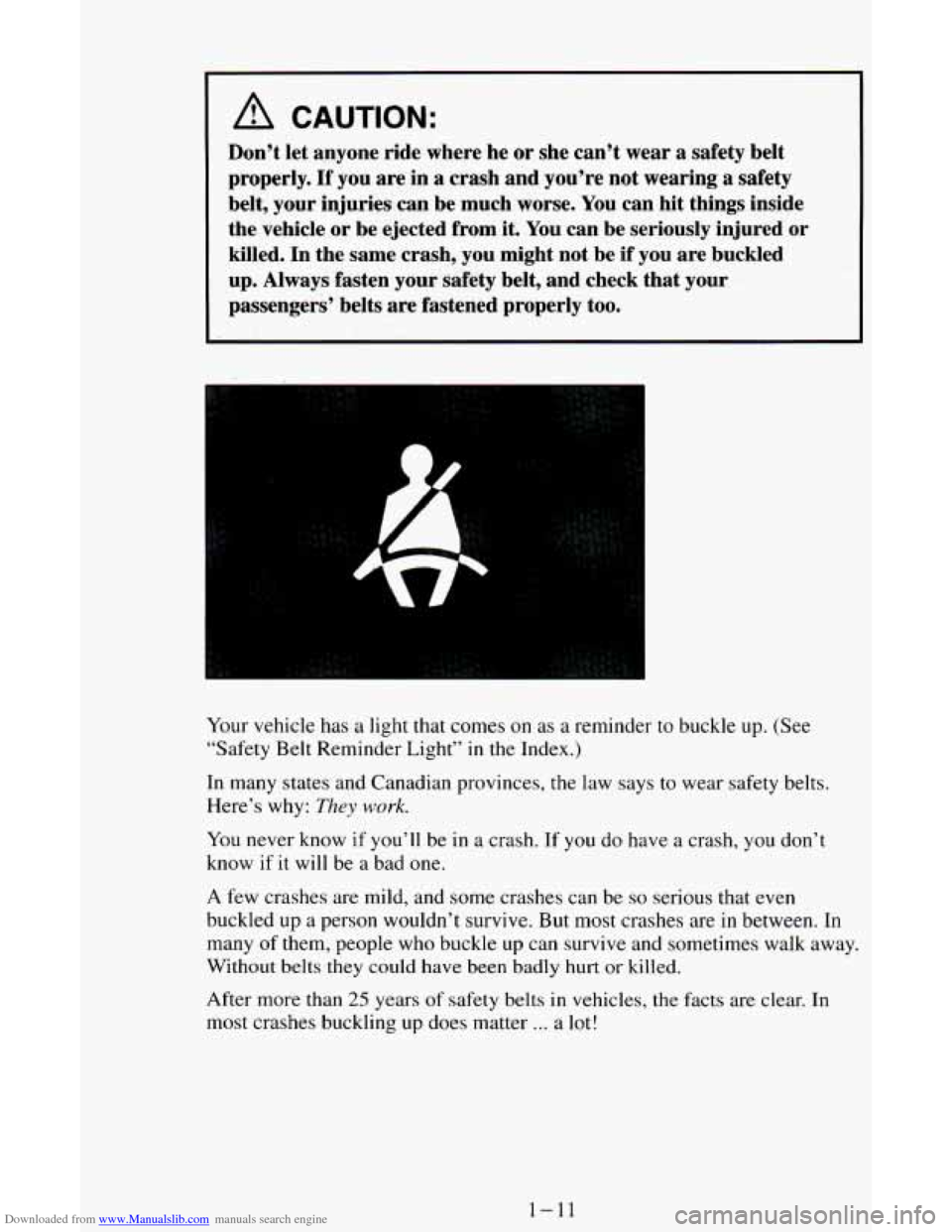
Downloaded from www.Manualslib.com manuals search engine A CAUTION:
Don’t let anyone ride where he or she can’t wear a safety belt
properly.
If you are in a crash and you’re not wearing a safety
belt, your injuries
can be much worse. You can hit things inside
the vehicle or be ejected from it. You
can be seriously injured or
killed. In the same crash, you might not be if you are buckled
up. Always fasten your safety belt, and check that your
passengers’ belts are fastened properly too.
Your vehicle has a light that comes on as a reminder to buckle up. (See
“Safety Belt Reminder Light”
in the Index.)
In many states and Canadian provinces, the law says to wear safety belts.
Here’s why:
They work.
You never know if you’ll be in a crash. If you do have a crash, you don’t
know
if it will be a bad one.
A few crashes are mild, and some crashes can be so serious that even
buckled up a person wouldn’t survive. But most crashes are in between. In
many of them, people who buckle up can survive and sometimes walk away.
Without belts
they could have been badly hurt or killed.
After more than
25 years of safety belts in vehicles, the facts are clear. In
most crashes buckling up does matter ... a lot!
1-11
Page 34 of 342
Downloaded from www.Manualslib.com manuals search engine There is an air bag readiness light on the instrument panel, which shows
AIR
BAG. The system checks the air bag’s electrical system for
malfunctions. The light tells you if there is an electrical problem. See
“Air
Bag Readiness Light” in the Index for more information.
How the Air Bag System Works
Where is the air bag?
The driver’s facial air bag is in the middle of the steering wheel.
1-22
Page 54 of 342
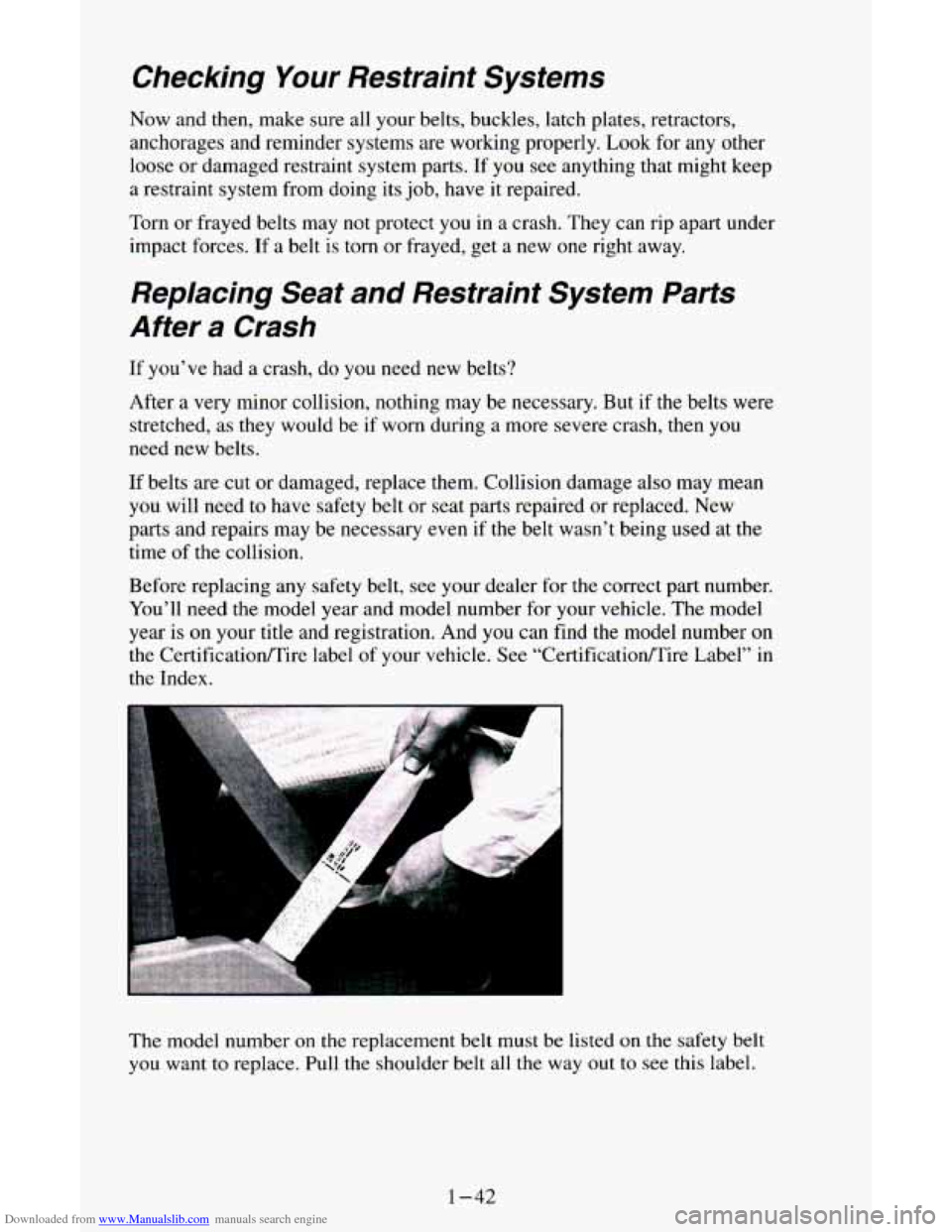
Downloaded from www.Manualslib.com manuals search engine Checking Your Restraint Systems
Now and then, make sure all your belts, buckles, latch plates, retractors,
anchorages and reminder systems are working properly.
Look for any other
loose or damaged restraint system parts. If you see anything that might keep
a restraint system from doing its job, have it repaired.
Torn or frayed belts may not protect you in a crash. They can rip apart under
impact forces. If a belt
is torn or frayed, get a new one right away.
Replacing Seat and Restraint System Parts
After a Crash
If you’ve had a crash, do you need new belts?
After a very minor collision, nothing may be necessary. But if the belts were
stretched, as they would be if worn during a more severe crash, then you
need new belts.
If belts are cut or damaged, replace them. Collision damage also may mean
you will need
to have safety belt or seat parts repaired or replaced. New
parts and repairs may be necessary even if the belt wasn’t being used at the
time of the collision.
Before replacing any safety belt, see your dealer for the correct part number.
You’ll need the model year and model number for your vehicle. The model
year is on your title and registration. And you can find the model number
on
the Certificatioflire label of your vehicle. See “Certificatioflire Label” in
the Index.
.,”.
The model number on the replacement belt must be listed on the safety belt
you want
to replace. Pull the shoulder belt all the way out to see this label.
1-42
Page 60 of 342
Downloaded from www.Manualslib.com manuals search engine Rear Doors
If you have the Dutch doors, you must open the hatch first.
To open the rear doors
from the outside, open
the right rear door
first. Grasp the handle
and pull the door
open.
To open the left rear
door, pull on the latch
release handle in the
inside of the door.
To close the rear doors, close the left door first. Check to make sure both
doors are completely closed.
The rear doors have
a check assembly to keep the doors from opening
beyond
90".
2-6
Page 61 of 342
Downloaded from www.Manualslib.com manuals search engine ..^
To fully open the
doors, push in on the
clip and lift the check
assembly up off the
mounting bracket.
Do
this on each door.
Replace the assemblies
the same
way.
See the caution under “Swing-Out Windows” in this section.
Door Locks
A CAUTION:
Unlocked doors can be dangerous.
2-7
Page 65 of 342
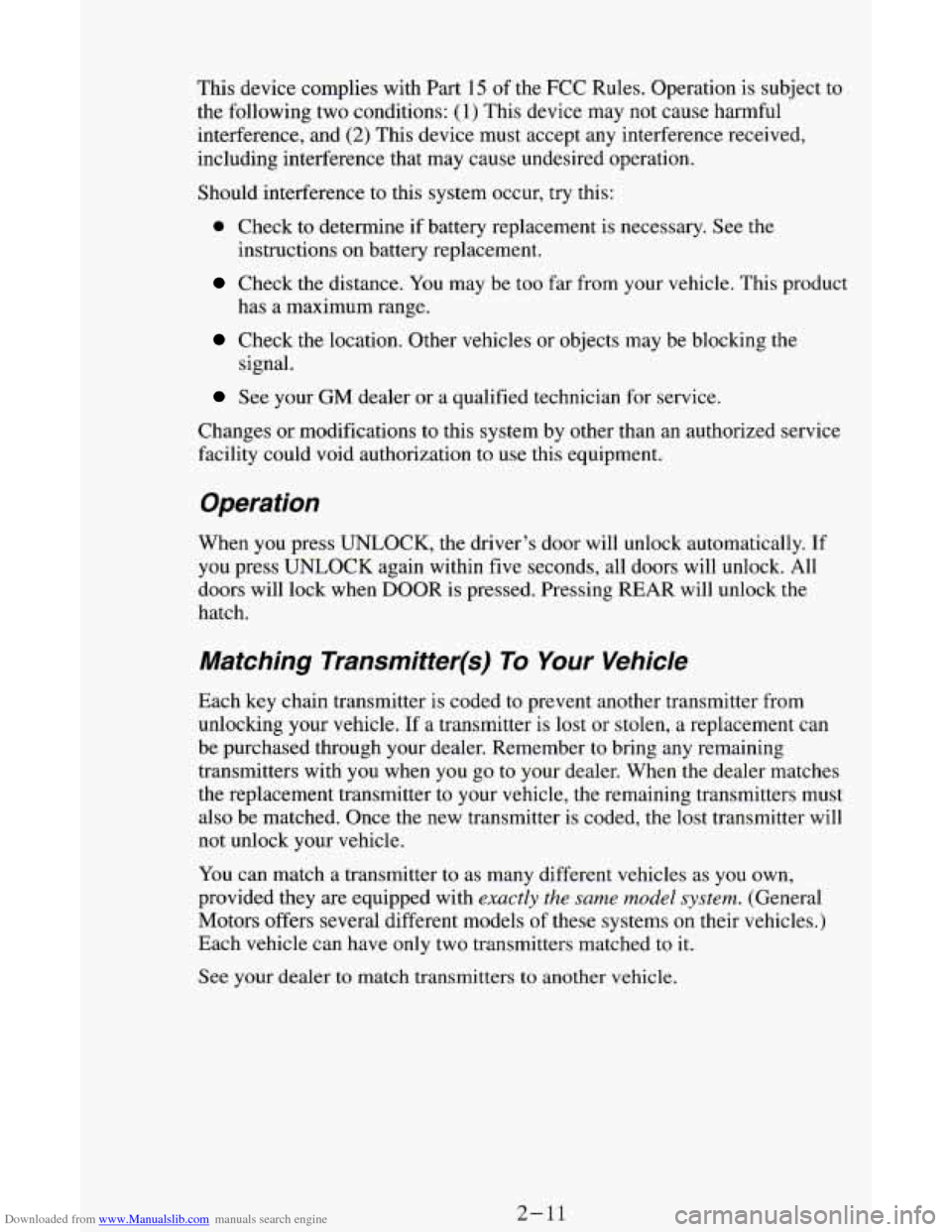
Downloaded from www.Manualslib.com manuals search engine This device complies with Part 15 of the FCC Rules. Operation is subject to
the following two conditions:
(1) This device may not cause harmful
interference, and
(2) This device must accept any interference received,
including interference that may cause undesired operation.
Should interference to this system occur, try this:
0 Check to determine if battery replacement is necessary. See the
instructions on battery replacement.
has a maximum range.
Check the distance. You may be too far from your vehicle. This product
Check the location. Other vehicles or objects may be blocking the
See your GM dealer or a qualified technician Tor service.
signal.
Changes or modifications to this system by other than an authorized service
facility could void authorization to use this equipment.
Operation
When you press UNLOCK, the driver’s door will unlock automatically. If
you press
UNLOCK again within five seconds, all doors will unlock. All
doors will lock when
DOOR is pressed. Pressing REAR will unlock the
hatch.
Matching Transmitter(s) To Your Vehicle
Each key chain transmitter is coded to prevent another transmitter from
unlocking your vehicle. If a transmitter is lost or stolen, a replacement can
be purchased through your dealer. Remember to bring any remaining
transmitters with you when you go to your dealer. When the dealer matches
the replacement transmitter to your vehicle, the remaining transmitters must
also be matched. Once the new transmitter is coded, the lost transmitter will
not unlock your vehicle.
You can match a transmitter to as many different vehicles as
you own,
provided they are equipped with
exactly the same model system. (General
Motors offers several different models
of these systems on their vehicles.)
Each vehicle can have only two transmitters matched
to it.
aee your dealer to match transmitters to another vehicle.
2-11
Page 70 of 342
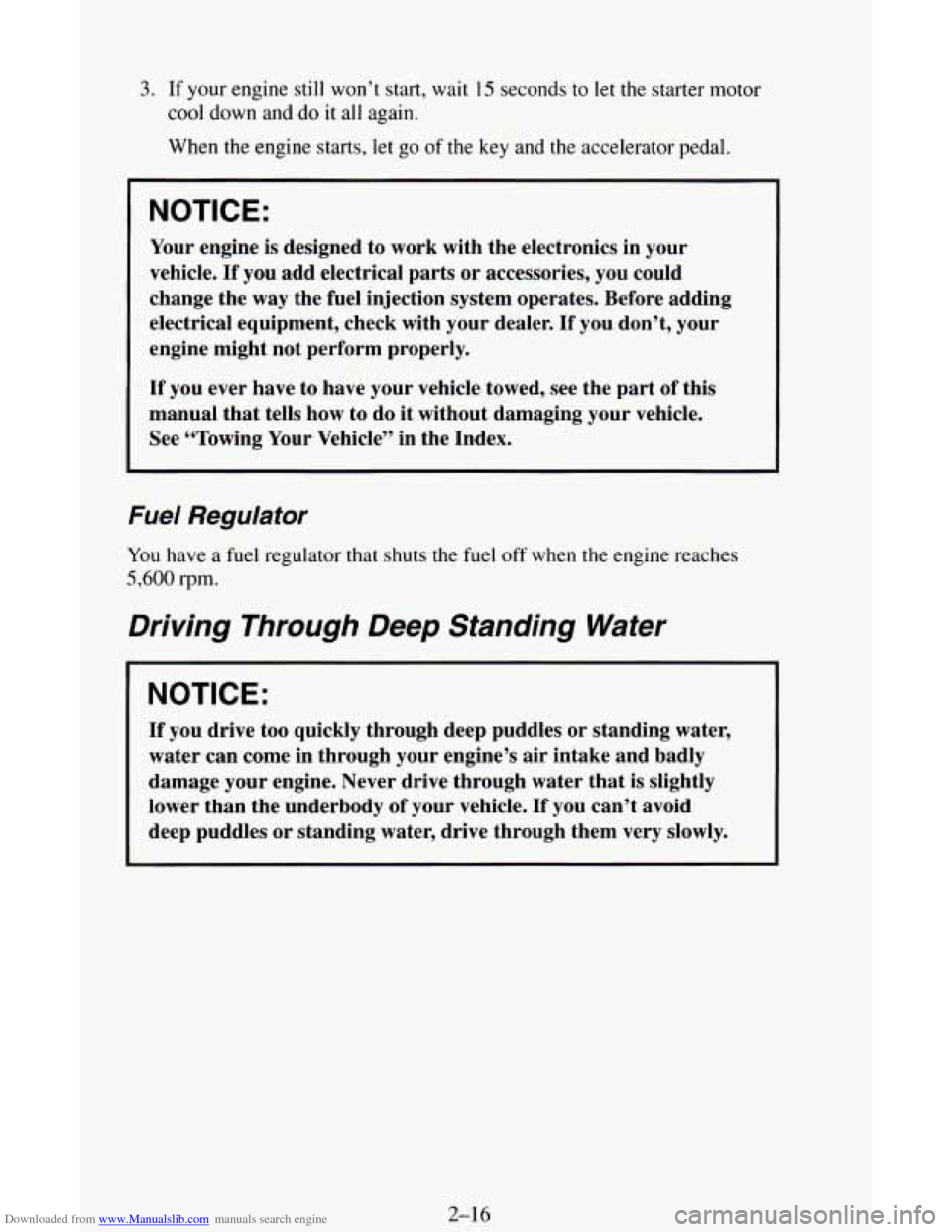
Downloaded from www.Manualslib.com manuals search engine 3. If your engine still won’t start, wait 15 seconds to let the starter motor
cool down and do it all again.
When the engine starts,
let go of the key and the accelerator pedal.
NOTICE:
Your engine is designed to work with the electronics in your
vehicle.
If you add electrical parts or accessories, you could
change the
way the fuel injection system operates. Before adding
electrical equipment, check with your dealer. If you don’t, your
engine might not perform properly.
If you ever have to have your vehicle towed, see the part of this
manual that tells how to do it without damaging your vehicle.
See “Towing Your Vehicle” in the Index.
Fuel Regulator
You have a fuel regulator that shuts the fuel off when the engine reaches
5,600 rpm.
Driving Through Deep Standing Water
NOTICE:
If you drive too quickly through deep puddles or standing water,
water can come in through your engine’s air intake and badly
damage your engine. Never drive through water that is slightly \
lower than the underbody
of your vehicle. If you can’t avoid
deep puddles or standing water, drive through them very slowly.
2-16
Page 85 of 342
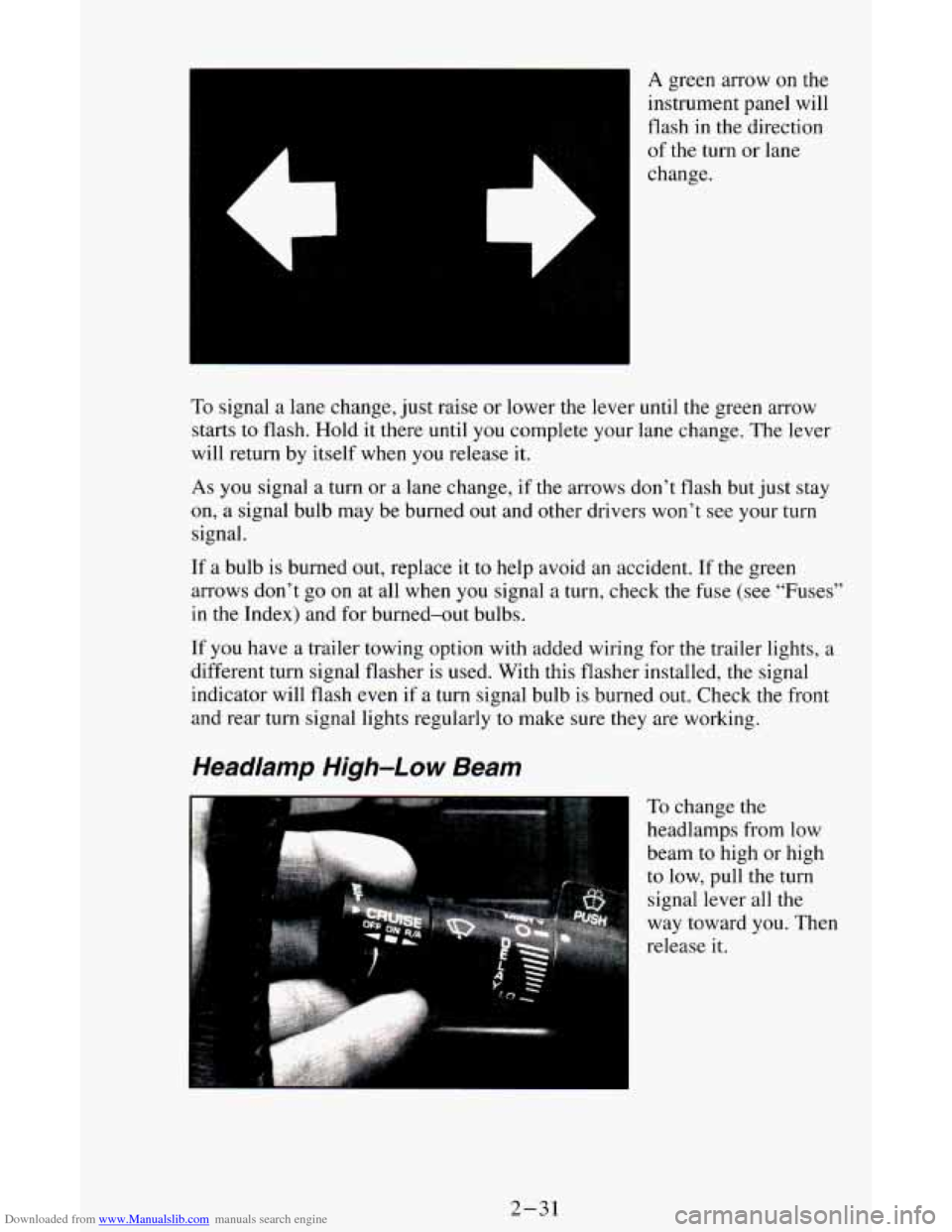
Downloaded from www.Manualslib.com manuals search engine A green arrow on the
instrument panel will
flash
in the direction
of the turn or lane
change.
To signal a lane change, just raise or lower the lever until the green arrow
starts to flash. Hold it there until
you complete your lane change. The lever
will return by itself when
you release it.
As you signal a turn or a lane change, if the arrows don’t flash but just stay
on, a signal bulb may be burned out and other drivers won’t see your turn
signal.
If a bulb is burned out, replace it to help avoid an accident. If the green
arrows don’t go
on at all when you signal a turn, check the fuse (see “Fuses”
in the Index) and for burned-out bulbs.
If you have a trailer towing option with added wiring for the trailer lights, a
different turn signal flasher is used. With this flasher installed, the signal
indicator will flash even if a turn signal bulb
is burned out. Check the front
and rear turn signal lights regularly
to make sure they are working.
Headlamp High-Low Beam
f ,.
To change the
headlamps from low
beam to high or high
to low, pull the turn
signal lever all the
way toward you. Then
release it.
2-31